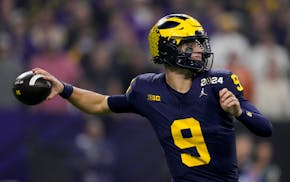Known as "The Loon Lady," retired wildlife biologist Pam Perry of Brainerd, Minn., has been named this year's recipient of a top wildlife achievement award.
One of state's original nongame wildlife biologists, Perry received the Minnesota Award from the state chapter of The Wildlife Society. Previous recipients include noted conservationist Richard Dorer and nationally known wildlife experts Gordon Gullion, Art Hawkins and David Mech.
"I've fallen into good company," Perry offered with humility. "The other women winners — Janet Green, Francesca Cuthbert, Janet Boe, Lee Pfannmuller and Margaret Anderson — are remarkable."
The award was a surprise to Perry, who retired five years ago from the Minnesota Department of Natural Resources after a 30-plus year career. A trail blazer, Perry was among the first women to earn a University of Minnesota undergraduate degree in wildlife management. She was among the DNR's first female wildlife biologists.
"Female wildlife biologists were pretty rare back in the early 1980s," said Carrol Henderson, her longtime supervisor. "I'd get calls from schools that wanted a wildlife biologist to give a talk, and I'd send Pam. I am sure she inspired many girls to pursue conservation careers because of her passion, knowledge and the cool things she got to do."
Below are reflections from Perry, edited for space:
On returning to Minnesota
I was working in Florida on an endangered species project when I was offered the chance to come back to Minnesota and be part of a recently created nongame wildlife program. The program got a real boost from then-state Sen. Collin Peterson. In 1981, he introduced language that would allow citizens to use their tax forms to voluntarily donate dollars to help loons, bald eagles and other unhunted species. Thanks to what became known as the Chikadee Checkoff, the nongame program's budget went from about $30,000 in 1981 to $500,000 in 1982, which was the year I started. I had an amazing opportunity to do new, different and needed work.
On the nongame wildlife program's early days
Carroll Henderson was our leader, and Jack Mooty, John Schladweiler, Katie Haws, Joan Galli and I were the first to be hired. We all had master's degrees, field experience and plenty of ideas but no map to follow. So, we charted our own course. We immediately focused on communication, education and information. Our annual wildlife posters were a big hit from the get-go. The front of the poster was always a stunning photo of a loon, swan or other species and the back was full of meaty information. Soon these posters were hanging in cabins, resorts and classrooms everywhere. We also did a ton of radio interviews, television interviews and public presentations. I was constantly telling a story of habitat and how it related to the birds, butterflies, snakes and other species people saw in their own backyard — or didn't see. I don't know how many talks I gave. Probably a 'bazillion.'
On accomplishments
Much of my work related to creating and conducting wildlife surveys because so little was known about the populations of Minnesota's bald eagles, loons, great blue herons, ospreys, bluebirds, red-shouldered hawks and other animals. This was pioneering work, as were the management plans that followed. I also directed conservation and research projects on the Camp Ripley military reservation. Habitat-wise, I helped facilitate a 110-acre donation that became the state's first landscaping for wildlife demonstration area. Similarly, I played a significant role in preserving a half-mile long stretch of undeveloped shoreline on the Whitefish Chain of Lakes. I was very active in promoting wildlife tourism, bluebird workshops, the benefits of keeping cats indoors, and the downsides of lead in our lakes.
On seeing a difference
My budget was based largely on the generosity of Minnesotans, so my peers and I focused on four high-priority areas we called the four H's: habitat, high-priority species, holistic thinking, and hands-on learning opportunities for citizens. This worked.
Over time, the state's trumpeter swan population rose from a few pairs to about 20,000. Eagles went from several hundred to several thousand. The bluebird population bounced back because people began to build nest boxes that provided much-needed nesting cavities. The loon watcher program I developed continues to provide valuable citizen science on numbers, locations and breeding success. Much of my career was connecting citizens to nature and those citizens connecting me to even more people who cared about nature. Pretty lucky.
C.B. Bylander is a freelance writer. He lives near Baxter, Minn.

Live: Vikings draft QB J.J. McCarthy, edge Dallas Turner
NFL Draft Latest: Caleb Williams to Bears, record six QBs taken in first 12 picks
2024 NFL Draft: List of first round picks

